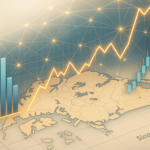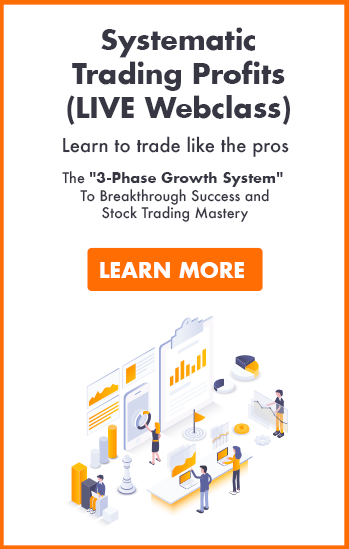GDP is a key economic measure that directly influences stock markets worldwide. Here’s the gist:
- What is GDP? GDP represents the total value of goods and services produced in a country. It reflects economic health and is broken into four parts: private consumption, investment, government spending, and net exports.
- Why does GDP matter for stocks? Strong GDP growth usually boosts corporate earnings and investor confidence, pushing stock prices up. Weak GDP, on the other hand, can lead to sell-offs and cautious market behaviour.
- How does GDP data move markets? Surprises in GDP figures – whether better or worse than expected – can cause sudden shifts. Traders often adjust portfolios based on these reports, especially in sectors tied to consumer spending, investment, or exports.
- Emerging vs. Developed Markets: Developed markets like the US show moderate reactions to GDP changes. Emerging markets, such as China and India, are more volatile, with larger swings in stock prices and currencies.
Want to trade smarter with GDP data? Focus on timing, sector-specific opportunities, and managing risks during volatile periods. Keep an eye on GDP releases from major economies like the US, China, and Europe – they ripple through global markets, including Singapore’s.
How GDP Data Moves Stock Markets
This section dives into how GDP data influences stock markets globally. For traders, understanding these connections can be a game-changer when navigating economic releases.
GDP Growth and Company Earnings
When GDP grows, it often leads to higher corporate revenues and profits. Why? A growing economy typically means more consumer spending and increased business investment. This uptick directly translates into stronger company earnings.
The earnings multiplier effect kicks in during sustained GDP growth. As companies report solid quarterly results, analysts frequently revise their forecasts upwards, creating momentum for share prices. This feedback loop – positive GDP data driving higher earnings expectations, which then push stock valuations higher – can significantly impact market movements.
For Singapore traders, this relationship is particularly important when tracking GDP data from major trading partners. For instance, robust GDP growth in China can benefit Singapore-listed companies with strong ties to Chinese markets, especially in industries like shipping, logistics, and manufacturing. These earnings gains can shift market sentiment, particularly when GDP figures defy expectations.
How GDP Surprises Affect Market Sentiment
Unexpected GDP figures can cause major ripples in the market. Since investors often price in consensus forecasts ahead of official releases, surprises – whether positive or negative – prompt rapid adjustments.
When GDP data beats expectations, it can trigger a risk-on sentiment, encouraging investors to move funds from safer assets like government bonds into higher-risk equities. On the flip side, disappointing GDP results often lead to sell-offs, as investors reassess economic growth prospects. The extent of the market’s reaction usually depends on how much the actual figures deviate from forecasts.
Traders often adjust their portfolios in anticipation of GDP releases to manage potential risks. For Singapore traders, these swings in sentiment can open up opportunities in regional markets, especially in sectors closely tied to global economic trends. Such shifts also play a role in shaping central bank policies, as explored in the next section.
GDP Trends and Central Bank Decisions
Central banks keep a close eye on GDP trends when crafting monetary policy, creating another link between economic data and stock market performance. The connection between GDP growth and interest rate decisions can have a profound impact on equity valuations.
When GDP growth exceeds central bank targets, policymakers might raise interest rates to prevent the economy from overheating. Higher interest rates increase borrowing costs for businesses and consumers, potentially slowing economic activity and squeezing corporate profits. For stock markets, rising rates also make bonds more appealing compared to equities, which can lead to capital outflows.
Additionally, higher interest rates mean higher discount rates, which lower the present value of future cash flows. This can drag down stock valuations, even in a strong economic environment.
Singapore traders should pay close attention to how the Monetary Authority of Singapore (MAS) responds to local GDP data, as well as the actions of major central banks like the Federal Reserve and European Central Bank. These policy decisions can significantly affect regional markets, particularly for interest-sensitive sectors such as real estate investment trusts and utilities.
The forward guidance provided by central banks adds another layer of complexity. When policymakers signal that future rate decisions will hinge on GDP trends, each new economic release becomes even more critical in shaping market trajectories. For traders who can anticipate how GDP surprises might influence central bank communications, this creates unique opportunities to capitalise on market movements.
GDP Impact: Developed Markets vs Emerging Markets
This section dives into how GDP affects developed and emerging markets differently, building on earlier discussions about GDP’s general market effects. Understanding these differences is essential for traders aiming to make the most of economic data releases. Each market type reacts uniquely to GDP figures, showing distinct patterns of volatility that demand tailored trading strategies. Let’s explore these nuances.
GDP Growth Rates and Market Reactions
In developed markets, annual GDP growth typically ranges between 1–3%. For example, when countries like the United States or Germany report a GDP growth rate of 2.5%, the market response is usually measured. These economies have well-established systems and diversified industries, which temper extreme market movements.
By contrast, emerging markets like China and India aim for higher GDP growth rates – around 5–6% and 6–7%, respectively. When these targets are met, their stock markets often see substantial rallies, accompanied by more pronounced and volatile shifts.
The difference lies in market maturity. Developed markets tend to price in steady, moderate growth, making them less reactive to small surprises. For instance, a 0.2% GDP surprise in the US might nudge the S&P 500 by 1–2%. Meanwhile, in an emerging market, a similar GDP surprise could send local indices soaring or plunging by 3–5% or more.
Singapore traders stand to gain from understanding these dynamics. As a hub connecting developed and emerging Asian markets, Singapore’s Straits Times Index (STI) reflects this dual exposure. Banking stocks in the STI often mirror trends from developed markets, while shipping and commodities stocks are more sensitive to emerging market GDP data.
Why Emerging Markets Are More Volatile
Emerging markets tend to react more dramatically to GDP data releases due to several factors:
- Currency vulnerability: Weak GDP figures often lead to foreign investors pulling out capital, causing both stock prices and local currencies to drop simultaneously.
- Reliance on foreign capital: These economies depend heavily on international investments to fuel growth. When GDP data signals weakness, funds are often redirected to safer developed markets, exacerbating local market declines.
- Economic structure: Emerging markets are typically more reliant on commodities or manufacturing tied to global supply chains. Slower GDP growth in these markets can indicate disruptions in these critical sectors, triggering sharper market responses.
- Political and institutional risks: Less established regulatory systems and greater political uncertainty make these markets more sensitive. Poor GDP data can heighten fears of policy changes or instability, amplifying market volatility.
Trading Tips for Different Market Types
To navigate these differences, traders should adjust their strategies based on the type of market:
- In developed markets, focus on sector rotation. Positive GDP data generally boosts cyclical sectors like financials and industrials, while weak data favours defensive sectors such as utilities and consumer staples. The market moves here are typically gradual, allowing for more measured adjustments.
- In emerging markets, it’s critical to tighten risk management. Higher volatility calls for smaller position sizes and tighter stop-losses. The rapid price swings following GDP releases can quickly turn gains into losses without proper safeguards.
- Currency hedging is also key when trading emerging market stocks around GDP announcements. Unexpected GDP results often lead to currency fluctuations, exposing traders to dual risks – stock price changes and exchange rate movements. Singapore-based traders can mitigate this risk using currency forwards or options.
- Timing matters. In developed markets, GDP-related moves can unfold over several days as institutional investors gradually adjust their portfolios. In emerging markets, the reaction tends to be more immediate but short-lived, as attention quickly shifts to the next piece of data.
- Correlation analysis can uncover opportunities. For instance, disappointing GDP data from a major emerging market might initially drag down related sectors in developed markets due to contagion fears. However, this often creates attractive entry points for patient traders once the dust settles.
- Pre-announcement periods offer unique chances. Developed markets usually have more accurate GDP forecasts, so surprises are less common but more impactful when they occur. Meanwhile, emerging markets often produce less reliable forecasts, creating more frequent – but riskier – trading opportunities around GDP releases.
Master Systematic Trading with Collin Seow
Learn proven trading strategies, improve your market timing, and achieve financial success with our expert-led courses and resources.
How Major Economy GDP Data Affects Global Markets
When the world’s largest economies release their GDP figures, the impact is felt across global markets. These effects stem from interconnected trade, investment, and supply chains. For traders in Singapore – situated at the heart of global commerce – understanding these dynamics is crucial. Let’s explore how key economies influence global market movements.
US, China, and Europe GDP: Global Effects
The United States, China, and Europe are pivotal in shaping global market sentiment. The US, in particular, plays a dominant role. Strong US GDP data typically strengthens the US dollar and boosts global risk appetite. This can lead to emerging market currencies losing value, which affects export competitiveness and raises the cost of servicing dollar-denominated debt.
In Singapore, the financial sector often reacts to shifts in the US economy. For example, robust US GDP figures can lift investor confidence in banking and finance, while weaker growth tends to create a more cautious market environment. Similarly, strong Chinese GDP data support industrial activity and shipping demand, which benefits Singapore’s trade and manufacturing sectors.
China’s economic health is especially significant for Singapore, given its close trade ties. Positive GDP data from China often signals increased industrial production and trade activity, directly benefiting regional industries. On the other hand, GDP figures from the European Union influence market confidence differently. Strong growth in Europe often drives higher consumer spending in areas like luxury goods and premium services, while weaker numbers can pressure businesses with exposure to European markets.
Cross-Border Stock Market Reactions
Stock markets worldwide tend to follow predictable patterns in response to GDP announcements. For instance, better-than-expected US GDP growth often leads to gains in several Asian markets, particularly in technology and export-driven sectors, as investors anticipate increased demand for regional goods.
Singapore’s benchmark indices frequently reflect these trends. Strong Chinese GDP data, for example, often coincides with rising performance in commodity-linked stocks, as heightened industrial activity drives demand for raw materials.
Regional reactions to GDP data can vary. Asian markets may take longer to respond to US GDP announcements, but often show sustained effects. In contrast, European markets typically react more immediately, especially when processing overnight developments. These cross-border movements highlight the importance of being tactically prepared for market shifts.
How to Prepare for Global Market Moves
Staying ahead of market volatility begins with tracking the economic calendar for major GDP releases. The US typically publishes its quarterly GDP figures a few weeks after the end of each quarter, while China and the European Union follow different schedules. Knowing these timelines helps traders anticipate potential market changes.
To prepare, traders can adjust portfolios by focusing on sectors sensitive to interest rate movements. It’s crucial to manage position sizes carefully, as unexpected GDP results can trigger significant volatility.
Sector rotation strategies can also be effective. For example, strong GDP data from China might favour industrial and materials stocks, while weaker figures could prompt a shift toward defensive sectors like utilities and telecommunications. Risk management remains essential – traders may want to reduce position sizes or use hedging tools like currency forwards or options to protect against sudden market fluctuations.
How to Trade Using GDP Data: Practical Steps
Using GDP data in trading requires careful planning, timely adjustments, and a disciplined strategy. Here’s how you can integrate these steps into your trading routine.
Track GDP Release Dates
The first step in GDP-based trading is knowing when key announcements are scheduled. Economic calendars are your go-to tool for staying updated on GDP release dates and nowcasts from major agencies. These dates provide critical signals to prepare your trading strategy.
For a deeper dive, consider monitoring the economic indicators that influence GDP calculations. For instance, the Federal Reserve Bank of Atlanta’s GDPNow model offers valuable insights. On 29 October 2025, it released its “Final nowcast of 2025:Q3 GDP growth”, followed by the “Initial nowcast of 2025:Q4 GDP growth” on 31 October 2025. These nowcasts are updated frequently based on data like the ISM Manufacturing Index and construction spending, giving traders an early edge before the official GDP numbers are released.
Adjust Your Trading Around GDP News
Once you’re aware of the release dates, it’s time to adjust your trading approach. To manage the volatility that often accompanies GDP announcements, consider these strategies:
- Reduce position sizes ahead of major releases to limit exposure to sudden market swings.
- Tighten stop-loss orders to protect your trades from unexpected GDP surprises, but leave enough room to avoid triggering them during normal market fluctuations.
- Wait for volatility to settle before opening new positions. This helps you avoid the erratic price movements that usually follow GDP announcements.
Sector rotation is another effective strategy during these times. For example, strong GDP growth often boosts cyclical sectors like technology, industrials, and consumer discretionary stocks. On the other hand, weaker GDP figures may shift focus to defensive sectors such as utilities and telecommunications. Preparing watchlists for both scenarios ensures you’re ready to act based on the data’s direction.
Learn Systematic Trading with Collin Seow Trading Academy

Trading around GDP data isn’t just about understanding the numbers – it’s about having a structured, emotion-free approach. The Collin Seow Trading Academy provides tools and resources to help you build this systematic mindset.
The academy offers free e-courses, live webinars, and a detailed guidebook, The Systematic Trader v.2. These resources teach you how to create a rules-based trading framework, especially for volatile periods like GDP announcements.
Live webinars are particularly valuable, offering real-time insights into how professional traders navigate GDP releases. You’ll learn practical strategies tailored to different economic scenarios and even have the chance to ask questions about specific trading situations.
The academy also emphasises the importance of mentorship and community. By connecting with experienced traders who’ve successfully integrated GDP analysis into their strategies, you can gain actionable insights and avoid common mistakes. This support network ensures you’re not navigating the complexities of GDP-based trading alone.
Conclusion: Main Points About GDP and Stock Markets
How GDP Influences the Market
GDP data plays a crucial role in shaping stock market trends worldwide. It impacts markets through three main pathways: company earnings expectations, investor sentiment, and central bank policy decisions. When GDP shows strong growth, it often signals higher revenues and profits for businesses, leading to rising share prices. On the flip side, a slowing GDP can hint at weaker earnings, which may trigger sell-offs. The element of surprise in GDP reports can amplify these reactions – unexpectedly strong figures can fuel market rallies, while disappointing numbers can cause sharp declines.
Market responses differ between developed and emerging economies. Developed markets, such as those in the United States and European Union, tend to react in a more measured way, focusing on how the data might influence future policies. In contrast, emerging markets often experience greater volatility, as investors quickly adjust their expectations and reallocate capital based on shifting growth prospects.
Additionally, strong GDP growth often raises the likelihood of interest rate hikes, which can impact bond yields and stock valuations. Conversely, weak GDP data may lead to stimulus measures, which typically benefit riskier assets like equities.
Practical Steps for Traders
Understanding GDP’s influence on markets can help traders refine their strategies. Incorporating GDP data into your trading routine gives you a structured way to identify opportunities. For instance, keeping track of GDP release schedules and adjusting your trades around these announcements can help you navigate the volatility they create.
For those looking to deepen their skills, Collin Seow Trading Academy offers valuable resources. The academy provides free e-courses and live webinars that teach traders how to use economic data, like GDP, to inform their decisions. Their programme, The Systematic Trader v.2, delivers actionable strategies designed to take the emotion out of trading during GDP-driven market swings.
The academy also emphasises the importance of mentorship and community. Engaging with experienced traders who have successfully navigated GDP announcements can help you avoid common mistakes and fine-tune your approach. Learning from real-world experiences can be a game-changer.
To make the most of GDP-related opportunities, focus on building your analytical skills and applying them consistently. The resources from the academy can guide you in developing a disciplined, systematic approach. By combining education with practice, you can position yourself to take advantage of the market movements GDP data often triggers.
FAQs
How does GDP data help traders predict stock market trends?
Traders often turn to GDP data as a key indicator of economic health, using it to anticipate potential stock market movements. When GDP is on the rise, it typically signals a robust economy, which can lift investor confidence and push stock prices higher. On the flip side, a slowdown in GDP growth might hint at economic troubles, which could lead to falling markets.
GDP also plays a role in shaping inflation and interest rates – two factors that directly impact stock performance. For example, if GDP grows too quickly, it could drive inflation and prompt higher interest rates, both of which might put pressure on stock valuations. Keeping an eye on GDP release dates and observing how markets react during these periods can offer traders valuable clues for short-term strategies.
By staying attuned to these connections, traders can make smarter decisions and better align their approaches with the broader economic landscape.
Why do GDP changes cause more market volatility in emerging economies compared to developed ones?
Emerging markets often face more pronounced swings in response to GDP changes. Why? They are more vulnerable to political instability, currency fluctuations, and economic uncertainty. These elements magnify the effects of any GDP shifts, leaving their stock markets particularly reactive.
On top of that, financial systems in these economies are usually less developed, and access to reliable data can be limited. This lack of infrastructure often results in sharper market reactions to macroeconomic changes. On the other hand, developed markets enjoy the advantages of stable political conditions and well-established financial systems. These factors act as a buffer, softening the blow of GDP fluctuations.
How can Singapore traders manage risks from unexpected GDP announcements?
To handle risks stemming from unexpected GDP announcements, traders in Singapore can take steps to minimise their exposure. One practical approach is diversifying portfolios, which spreads investments across different assets or sectors, reducing reliance on any single one. Another useful tool is the use of stop-loss orders, which can help cap potential losses during times of increased market instability.
Keeping a close eye on GDP updates from the Ministry of Trade and Industry (MTI) is equally important. Staying informed allows traders to adapt their strategies swiftly as new information emerges. For those seeking a more structured approach, systematic trading strategies, like those taught at Collin Seow Trading Academy, offer a disciplined way to navigate market uncertainties while managing risks effectively.












